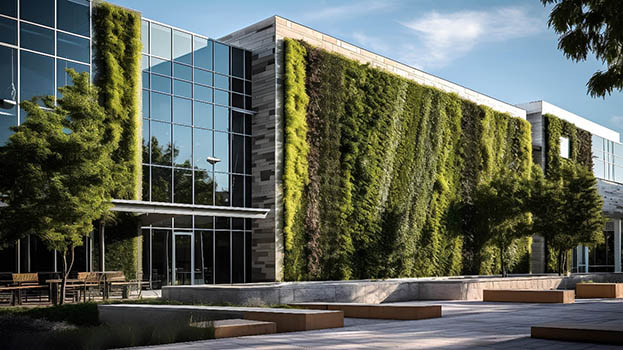In an age where urban environments dominate, finding innovative ways to reintegrate nature into our daily lives is crucial for the well-being of city dwellers. Biophilic design, which seeks to connect people more closely to the natural environment through urban planning and architecture, offers a promising path forward. Melanie Wilson of Savannah explains that this approach not only enhances the aesthetic value of urban spaces but also contributes significantly to the physical and mental health of its residents.
Understanding Biophilic Design
The term “biophilic design” was popularized by American biologist Edward O. Wilson in the 1980s, based on the idea that humans possess an innate tendency to seek connections with nature and other forms of life. Melanie Wilson of Savannah explains that biophilic design harnesses this inclination by incorporating natural elements, materials, and forms into the built environment.
Fundamentally, biophilic design revolves around three core principles:
- Direct nature inclusion: Integrating physical natural elements like plants, water bodies, sunlight, and natural landscapes into building designs.
- Indirect nature inclusion: Using nature-derived shapes, forms, materials, and colors to evoke the feeling of being in a natural setting.
- Nature of the space: Designing spaces that mimic the open, expansive, or sheltered environments found in nature, which influences the way people feel within a space.
Advocating for Nature: Melanie Wilson’s Vision for Biophilic Design in the Civic Center Redevelopment
During the public engagement process for the redevelopment of the Civic Center, Melanie Wilson, the Executive Director at the Chatham County-Savannah Metropolitan Planning Commission, strongly advocated for incorporating biophilic design principles into the project. With her extensive background in urban planning and her position as a former chair of the Planning and the Black Community Division of the American Planning Association, Wilson brought a deep understanding of how urban spaces can significantly impact community well-being. She expressed a desire for the Civic Center’s redevelopment to serve as a model for sustainable urban development, emphasizing the importance of natural elements in enhancing urban environments. Her advocacy highlighted the potential for biophilic design to transform the Civic Center into a space that not only meets the aesthetic and functional needs of the community but also promotes health, well-being, and social interaction among its users. Wilson’s input was instrumental in shaping the conversation around sustainable urban planning, ensuring that the project considered long-term environmental and social benefits alongside immediate urban development needs.
Benefits of Biophilic Design
The benefits of biophilic design are broad and impactful. Firstly, it significantly enhances mental health by reducing stress, enhancing creativity and clarity of thought, and improving mood and sense of well-being. Melanie Wilson of Savannah says that studies have shown that spaces that incorporate nature significantly contribute to reduced levels of mental fatigue and higher satisfaction rates among their occupants.
Physically, biophilic elements like plants improve air quality, which can decrease the risk of respiratory diseases and enhance overall health. Moreover, natural light has been shown to regulate circadian rhythms, improving sleep quality and overall vitality.
Socially, biophilic design can enhance community interactions. Melanie Wilson of Savannah understands that natural communal spaces encourage social cohesion and facilitate interactions among residents, fostering a sense of community and belonging.
Implementing Biophilic Design in Urban Areas
- Urban Parks and Green Spaces
One of the most straightforward implementations of biophilic design is the integration of urban parks and green spaces. These areas not only serve as lungs for cities, offering a respite from the concrete jungle, but also as social hubs for community activities. Cities like Singapore and Vienna have successfully implemented large-scale green spaces in their urban planning, which serve both ecological and social functions. - Green Buildings and Vertical Gardens
Another approach is the development of green buildings which integrate plant life directly into the structure. This can range from simple green roofs to sophisticated vertical gardens that cover entire facades. The Bosco Verticale in Milan, Italy, is a prime example, featuring two residential towers that incorporate more than 900 trees and numerous plants on its balconies, effectively creating a vertical forest. - Water Features
Incorporating water features like ponds, fountains, and streams into urban designs can also significantly enhance the aesthetic and sensory experience of city environments. The sound of water is universally calming and can serve as a counterpoint to the often overwhelming noise pollution of urban settings. - Natural Shapes and Forms
The use of organic, non-linear architectural forms that mimic the randomness and fluidity of nature can also make urban spaces more engaging and comfortable. This can be seen in the design of buildings with natural lighting, open-air atriums, and interiors that incorporate natural materials such as wood and stone.
Challenges and Considerations
While the benefits are clear, the implementation of biophilic design in urban planning is not without challenges. Melanie Wilson of Savannah explains that these include:
- Cost: Initial costs for integrating natural elements into buildings and urban spaces can be high. However, these are often offset by the long-term health and environmental benefits.
- Maintenance: Natural elements require maintenance, which can be resource-intensive. Sustainable maintenance strategies are essential for the long-term viability of biophilic elements.
- Cultural Adaptation: Biophilic design must be adapted to fit the cultural, climatic, and contextual nuances of different urban environments to be truly effective.
As urban areas continue to expand, the integration of natural elements through biophilic design is not just desirable but necessary for the future health and well-being of urban residents. Melanie Wilson of Savannah emphasizes that by fostering a deeper connection with nature, cities can become more livable, sustainable, and harmonious places for their inhabitants. The path forward involves architects, planners, and city dwellers embracing the challenge of designing spaces that bridge the gap between the built environment and the natural world, creating a seamless integration that benefits all.








